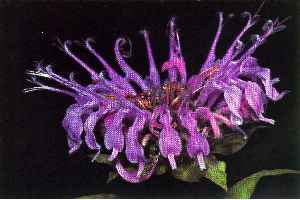
Britton, N.L., and A. Brown. 1913. Illustrated flora of the northern states and Canada. Vol. 3: 132.
Sunset®: All zones
USDA: 3-9
Frost Tolerance: Dies back to the ground in winter
Heat Tolerance: Light shade in Phoenix
Sun Exposure: Full sun to light shade
Origin: North America, east of the Rockies
Growth Habits: Herbaceous perennial, 2 to 4 feet tall (60-120 cm), 2 to 3 feet spread (60-90 cm); fragrant leaves, 2 to 4 inches long (5-10 cm)
Flowers: Pink flowers
Watering Needs: Regular water, prefers moist, well drained, soil in summer, drier in winter
Propagation: Seeds sown in place in spring or fall, self-sows, cuttings of new growth in the spring

Robert H. Mohlenbrock. USDA NRCS. 1992. Western wetland flora: Field office guide to plant species.
The leaves of the plant have been used traditionally to make a strongly mint flavored tea, supposed to have a number of medicinal qualities, 1 teaspoon of dried leaves to 8 ounces of boiling water. The leaves can be added fresh, in small quantities, to salad, desserts and drinks. The name 'bergamot' comes from the similarity of its scent with Citrus bergamia, the bergamot orange, a tree grown in southern Italy.
The flowers are very attractive to bees and hummingbirds.
Blooming Habits:
Rose-purple to lavender, two-lipped, tubular flowers, 1.5 inches long (4 cm), in mid-summer. Deadhead to extend the blooming period.
Culture:
Less susceptible to powdery mildew than Monarda dydima.
Desert-Tropicals is dedicated to provide gardening advice, gardening ideas, and information about flower of all kind for landscape and collections.We try to check carefully the identification of the plants on the illustrations as well as the other information from the page, but occasionally errors do occur. if you notice anything that needs to be changed please contact us.Thanks.
© 1998-2020 Philippe Faucon, All Rights Reserved.